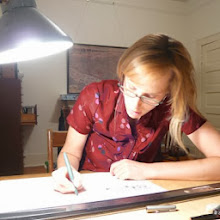 I attended Savannah College of Art & Design's Preservation Week lectures seven years ago, considering graduate study in Historic Preservation. This year, I made it a priority, again considering further study and also to fortify my ongoing interest in the field of Preservation and Architecture.
I attended Savannah College of Art & Design's Preservation Week lectures seven years ago, considering graduate study in Historic Preservation. This year, I made it a priority, again considering further study and also to fortify my ongoing interest in the field of Preservation and Architecture.Frank Sanchis. From 1986 to 1999, he served as vice president, Stewardship of Historic Sites at the National Trust for Historic Preservation. He gave a tour of Philip Johnson's Glass House, the details of its acquisition and maintanance and personality you probably won't hear at the actual site tour - although I would really like to see it now, with the outline of its back story in mind. Mr. Sanchis told the story, then, of Eero Saarinen's TWA Terminal at JFK Airport in NYC, highlighting the complexity of Adaptive Re-use holding hands (or not) with Preservation. Last, the Marine Teminal in Miami came to light (which I hope to explore in a few weeks.) A soaring concrete (poured!) structure by Cuban Architect Hilario Candela built on a pier whose stage is the water, showcasing water races, shows, sometimes a band or performance on a floating stage. It is abandoned but SAVED by local activism, waiting for Revitalization. I am anxious to see it in a few weeks! Images of Marine Stadium HERE.
 Buildings of the Modern era are coming up for renewal, and some are lost already. With a plethora of technologies and materials that were new (and experiemental) in the mid-century, some failed. How do we preserve the icons and make the buildings live on to serve viable uses?
Buildings of the Modern era are coming up for renewal, and some are lost already. With a plethora of technologies and materials that were new (and experiemental) in the mid-century, some failed. How do we preserve the icons and make the buildings live on to serve viable uses?Carl Elefante. “the greenest building is…one that is already built” caught my attention. It's what we espouse at our office. Elefante is an architect with a comprehensive understanding of how preservation is essential to new building. This is great to see, because many architects seem to believe preservation is only a hindrance to building new. Mr. Elefante began with the Historic Preservation Act of 1966, his own formative years at Pratt in NYC that melded Architecture and Preservation and Sustainability into his ethics. He clarified what "green" building really is - not replacing your 1920s hand-built windows with high-tech energy-efficient windows with a 20-year seal, but selectively replacing pieces for greater efficiency while retaining the whole window as a hand-built element that can continue to be updated, rebuilt as needed - not just thrown out when the seal breaks and the high-tech is not longer intact [paraphrased.] "sophisticated thought, not systems."
He stressed the need for preservationists to understand sustainability and dialogue with builders and architects (or be builders and architects) to show how prolonging the life of a building by replacing elements of like character that will last is the most "green." Our task, then, is to work with the mid-century buildings in the manner because these structures of modernism which represent 16% of the US building stock are at the tipping point now of demolition or preservation.
"In the 1920s we Americans built the best cities. In the 1950s, we became the best at destroying cities."
I hope we are building back the cities in 2010.
Elefante's ending: "Find hope out of the despair you're being handed."
Check out The Greenest Building in his own words.









No comments:
Post a Comment